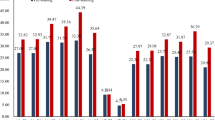Abstract
Scientific evidence supporting the reliability of neurofeedback (NF) in modifying the electroencephalographic (EEG) pattern is still limited. Several studies in NF research and clinical setting have been focused to increase sensory-motor rhythm (SMR) and simultaneously decrease theta activity with the aim of increasing attention performance and reducing hyperactive and impulsive behaviors. The goal of the present study was to assess the efficacy of NF training to enhance the SMR/theta ratio across sixteen sessions of training in eight healthy volunteers. Results suggested an increase of SMR/theta across weeks of training. Theta activity was strongly and steadily inhibited since the first session of training with slight decreases in the following weeks; instead, SMR was strongly inhibited at the beginning and progressively increased across sessions. These results suggest that individuals are able to inhibit theta activity easily while they fail to increase SMR in the first sessions. On the other hand, a separate analysis performed on the baseline preceding NF revealed a decreasing trend of SMR/theta ratio across the 8 weeks of training. Results point to the importance of providing EEG data in addition to behavioral modification, during NF training, to avoid possible misinterpretation of results.


Similar content being viewed by others
References
Arns M, De Ridder S, Strehl U, Breteler M, Coenen A (2009) Efficacy of neurofeedback treatment in ADHD: the effects on inattention, impulsivity and hyperactivity: a meta-analysis. Clin EEG and Neurosci 40:180–189
Cho MK, Jang HS, Jeong SH, Jang IS, Choi BJ, Lee MGT (2008) Alpha neurofeedback improves the maintaining ability of alpha activity. NeuroReport 19:315–317
Dempster T, Vernon D (2009) Identifying indices of learning for alpha neurofeedback training. Appl Psychophysiol Biofeedback 34:309–318
Egner T, Zech T, Gruzelier J (2004) The effects of neurofeedback training on the spectral topography of the electroencephalogram. Clin Neurophysiol 115:2452–2460
Gruzelier J, Egner T, Vernon D (2006) Validating the efficacy of neurofeedback for optimising performance. Prog Brain Res 159:421–431
Gruzelier J, Inoue A, Smart R, Steed A, Steffert T (2010) Acting performance and flow state enhanced with sensory-motor rhythm neurofeedback comparing ecologically valid immersive VR and training screen scenarios. Neurosci Lett 480:112–116
Jacobs G, Benson H, Friedman R (1996) Topographic EEG mapping of the relaxation response. Biofeedback Self Regul 21:121–129
Messerotti BS, Buodo G, Leone V, Palomba D (2011) Neurofeedback training for Tourette Syndrome: an uncontrolled single case study. Appl Psychophysiol Biofeedback 36:281–288
Ros T, Moseley MJ, Bloom PA, Benjamin L, Parkinson LA, Gruzelier JH (2009) Optimizing microsurgical skills with EEG neurofeedback. BMC Neurosci 10:87
Teplan M, Krakovská A, Štolc S (2006) EEG responses to long-term audio–visual stimulation. Int J Psychophysiol 59:81–90
Thompson M, Thompson L (2003) The neurofeedback book. An introduction to basic concepts in applied psychophysiology. The Association for Applied Psychophysiology and Biofeedback, Wheat Ridge
Thompson L, Thompson M, Reid A (2010) Neurofeedback outcomes in clients with Asperger’s syndrome. Appl Psychophysiol Biofeedback 35:63–81
Vernon D, Egner T, Cooper N, Compton T, Neilands C, Sheri A, Gruzelier J (2003) The effect of training distinct neurofeedback protocols on aspects of cognitive performance. Int J Psychophysiol 47:75–85
Zoefel B, Huster RJ, Herrmann CS (2011) Neurofeedback training of the upper alpha frequency band in EEG improves cognitive performance. Neuroimage 54:1427–1431
Acknowledgments
This study was supported by two post-doc fellowships from FSE (European Social Founding) and Regione Veneto granted to A. Alessandro, recipients M. de Zambotti and M. Bianchin. Authors would also like to thank Righetto s.r.l. for technical support and instrumental supply.
Conflict of interest
None.
Author information
Authors and Affiliations
Corresponding author
Rights and permissions
About this article
Cite this article
de Zambotti, M., Bianchin, M., Magazzini, L. et al. The efficacy of EEG neurofeedback aimed at enhancing sensory-motor rhythm theta ratio in healthy subjects. Exp Brain Res 221, 69–74 (2012). https://doi.org/10.1007/s00221-012-3148-y
Received:
Accepted:
Published:
Issue Date:
DOI: https://doi.org/10.1007/s00221-012-3148-y




